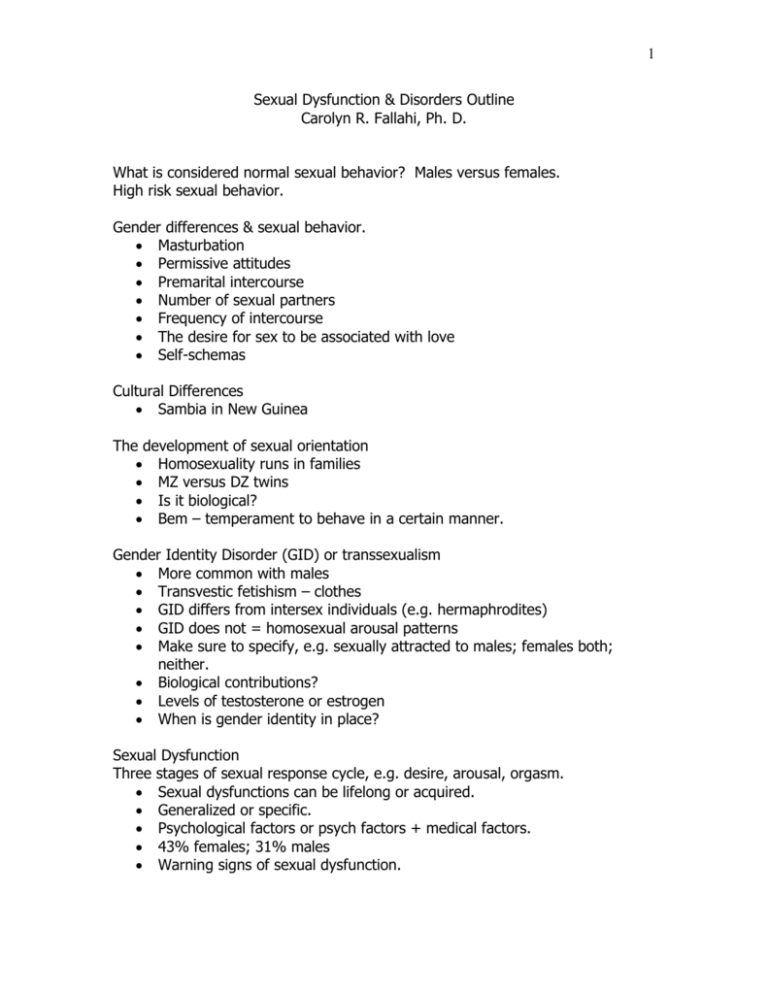
1
Sexual Dysfunction & Disorders Outline
Carolyn R. Fallahi, Ph. D.
What is considered normal sexual behavior? Males versus females.
High risk sexual behavior.
Gender differences & sexual behavior.
Masturbation
Permissive attitudes
Premarital intercourse
Number of sexual partners
Frequency of intercourse
The desire for sex to be associated with love
Self-schemas
Cultural Differences
Sambia in New Guinea
The development of sexual orientation
Homosexuality runs in families
MZ versus DZ twins
Is it biological?
Bem – temperament to behave in a certain manner.
Gender Identity Disorder (GID) or transsexualism
More common with males
Transvestic fetishism – clothes
GID differs from intersex individuals (e.g. hermaphrodites)
GID does not = homosexual arousal patterns
Make sure to specify, e.g. sexually attracted to males; females both;
neither.
Biological contributions?
Levels of testosterone or estrogen
When is gender identity in place?
Sexual Dysfunction
Three stages of sexual response cycle, e.g. desire, arousal, orgasm.
Sexual dysfunctions can be lifelong or acquired.
Generalized or specific.
Psychological factors or psych factors + medical factors.
43% females; 31% males
Warning signs of sexual dysfunction.
2
Sexual Desire Disorders
Hypoactive sexual desire disorders. 22% women; 5% men.
Sexual aversion disorder: the role of panic disorder. Specify type.
Warning signs.
Sexual arousal disorders. Outdated terms. Specify type.
o 40% males = occasional erectile & ejaculatory difficulties; 63%
women. Relationship to sexual satisfaction?
Erectile dysfunction 5% males; increases with age.
Female arousal disorders – difficult to estimate; maybe 14%
Orgasm Disorders:
Inhibited orgasm (female & male orgasmic disorder). 25% women; 50%
men = who seek therapy for sexual problems. Specify type.
Premature ejaculation: 21% men. Issue – difficult to define “premature”.
Surveys 1 to 2 minutes after penetration. Issue = lack of control. Specify
type.
Sexual Pain Disorders:
Dyspareunia: 1% to 5% men; 10% to 15% women. Specify type.
Warning signs.
Vaginismus: 5% women who seek treatment; higher rates in
conservative countries. Specify type.
Assessing Sexual Behavior
Psychophysiological assessment.
Nocturnal penile tumescence (NPT)
Penile strain gauge
Vaginal photoplethysmograph
Causes of Sexual Dysfunction:
Biological contributions
Prescription medications
Psychological issues, e.g. performance anxiety, cognitive issues,
physiological issues, emotional issues, social & cultural contributions,
relationship issues, script theory of sexual functioning. The final word?
Paraphilia: What is it? Comorbid problems?
Fetishism
Partialism
Voyeurism
Exhibitionism
Transvestic Fetishism
Sexual sadism & masochism
3
Sadistic rape
Pedophilia
Warning signs of pedophilia
Telephone scatologia
Frotteurism
Causes of pedophilia








